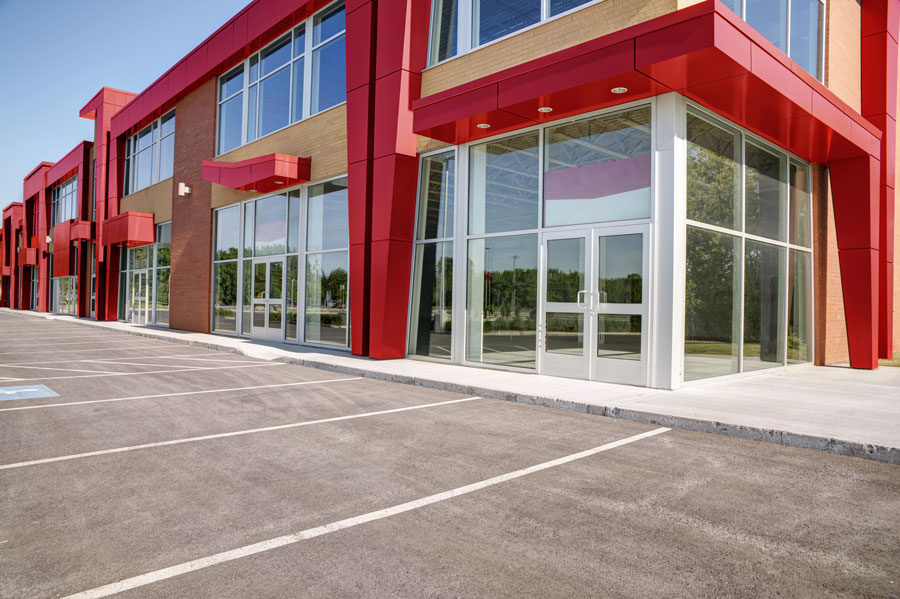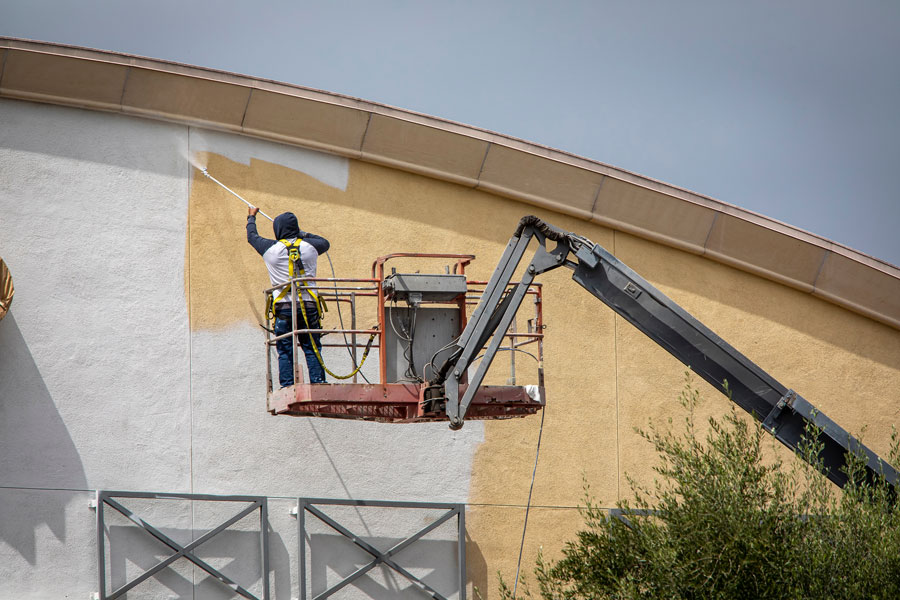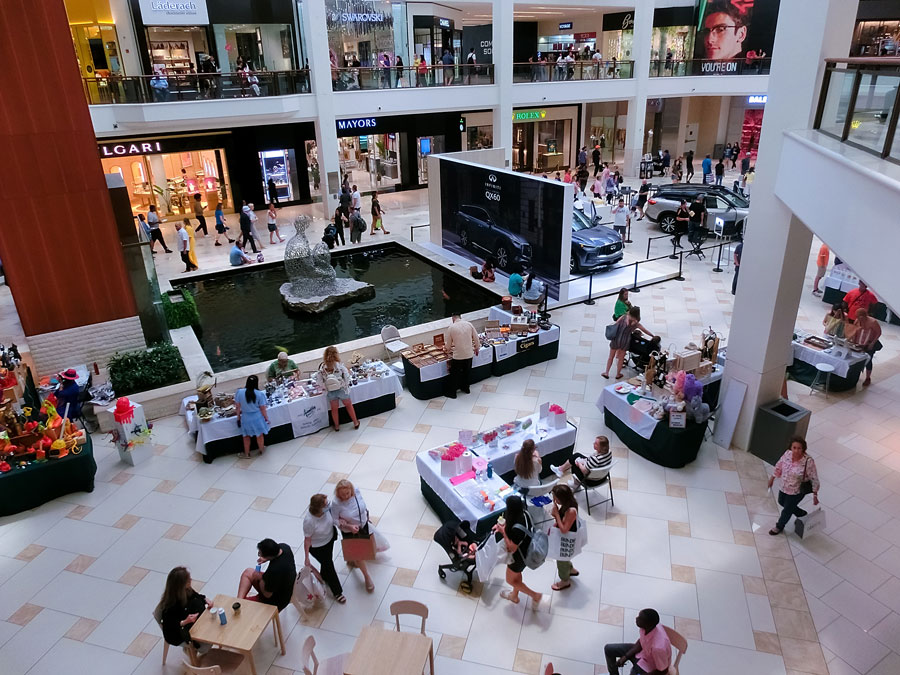When it comes to maintaining the appeal and functionality of shopping malls, the importance of a durable and well-applied paint job cannot be overstated. The right paint not only enhances the aesthetic appeal of a mall, making it more attractive to customers, but it also plays a crucial role in protecting the structure from environmental damage and reducing maintenance costs over time.
In this blog post, we’ll delve into the best practices for painting shopping malls to ensure longevity and durability. From selecting the right type of paint to proper surface preparation and application techniques, we’ll cover everything you need to know to keep your mall looking fresh and vibrant for years to come. So, whether you’re a mall owner, property manager, or a professional painter, read on to discover the secrets to a long-lasting paint job that can withstand the hustle and bustle of daily mall life.
Choosing the Right Paint
Selecting the appropriate paint for a shopping mall is critical for ensuring its durability and maintaining its appearance over time. Here are some key considerations to keep in mind:
Quality Over Cost
While it might be tempting to opt for cheaper paint options, investing in high-quality paint can save you money in the long run. Quality paints tend to last longer, require fewer touch-ups, and offer better protection against environmental elements.
Types of Paint
- Acrylic Paint:
- Durability: Acrylic paints are known for their long-lasting nature and resistance to fading, cracking, and weathering.
- Versatility: Suitable for both interior and exterior surfaces, making them a versatile choice for various areas of the mall.
- Maintenance: Easy to clean, which is ideal for high-traffic areas where dirt and grime can accumulate.
- Epoxy Paint:
- Toughness: Epoxy paint is exceptionally durable and resistant to heavy wear and tear, making it perfect for areas with high foot traffic.
- Chemical Resistance: It can withstand spills and stains, making it ideal for food courts and restrooms.
- Longevity: Provides a long-lasting finish that can endure the daily rigors of a bustling mall.
- Elastomeric Paint:
- Weather Resistance: Elastomeric paint is designed to expand and contract with the building, providing excellent protection against harsh weather conditions.
- Crack Bridging: It can fill and bridge small cracks, preventing water infiltration and damage to the underlying structure.
- Exterior Use: Best suited for exterior walls, offering superior protection against rain, wind, and temperature fluctuations.
Color and Finish
- Color Selection: Choose colors that not only enhance the mall’s aesthetic appeal but also align with branding and design themes. Lighter colors can make spaces feel larger and more inviting, while darker shades may be suitable for specific areas like theaters or intimate dining spaces.
- Finish Types:
- Matte Finish: Provides a non-reflective surface that hides imperfections well, suitable for ceilings and low-traffic areas.
- Satin and Eggshell Finish: Offers a slight sheen that is easy to clean and maintain, making it ideal for hallways and common areas.
- Gloss and Semi-Gloss Finish: Highly durable and easy to wipe clean, perfect for doors, trim, and high-touch surfaces.
Choosing the right paint is the first step in ensuring your mall remains visually appealing and structurally protected. In the next section, we’ll discuss how to properly prepare surfaces to maximize the paint’s effectiveness and longevity.

Preparing the Surface
Proper surface preparation is crucial for ensuring that the paint adheres well and lasts longer. Neglecting this step can lead to peeling, cracking, and an overall lackluster finish. Here are the essential steps for preparing surfaces in a mall for painting:
Cleaning
- Dust and Debris Removal:
- Sweeping and Dusting: Begin by thoroughly sweeping and dusting the surfaces to remove loose dirt and debris.
- Pressure Washing: For exterior walls, use a pressure washer to remove stubborn dirt, mold, mildew, and old paint residues. Ensure the surface is completely dry before proceeding.
- Degreasing:
- Detergent Solutions: Use a mild detergent solution to clean greasy or oily spots, especially in food courts and restrooms.
- Rinse and Dry: Rinse the area with clean water and allow it to dry completely to prevent moisture from affecting the paint adhesion.
Priming
- Importance of Primer:
- Enhanced Adhesion: A primer creates a smooth, uniform surface that helps the paint adhere better.
- Sealing: It seals porous surfaces, preventing the paint from soaking in and ensuring an even finish.
- Stain Blocking: Primers can block stains and prevent them from bleeding through the topcoat.
- Choosing the Right Primer:
- Surface-Specific Primers: Use primers specifically designed for the surface you’re painting, whether it’s concrete, wood, metal, or drywall.
- Tinted Primers: Consider tinted primers that match the topcoat color to improve coverage and reduce the number of coats needed.
Repairing Damages
- Inspecting for Damages:
- Cracks and Holes: Thoroughly inspect the surfaces for cracks, holes, and other imperfections.
- Moisture Damage: Check for signs of moisture damage, such as bubbling or peeling paint, which could indicate underlying issues.
- Repair Techniques:
- Filling Cracks and Holes: Use appropriate fillers or spackling compounds to fill in cracks and holes. Smooth the surface with a putty knife and sand it down once it’s dry.
- Sanding: Sand the repaired areas to ensure they are level with the rest of the surface, providing a smooth base for painting.
- Patching: Larger areas of damage may require patching with new drywall or plaster, followed by priming.
Proper surface preparation not only enhances the adhesion of the paint but also ensures a smooth, professional finish that can withstand the wear and tear of daily mall activities. In the next section, we’ll explore the best application techniques to achieve a flawless and durable paint job.

Application Techniques
Applying paint correctly is just as important as choosing the right paint and preparing the surface. Proper techniques ensure an even, durable finish that can withstand the daily demands of a busy shopping mall. Here are the best practices for painting mall surfaces:
Proper Tools
- Brushes:
- Natural Bristle Brushes: Ideal for oil-based paints, providing a smooth finish.
- Synthetic Bristle Brushes: Best for water-based paints, as they hold their shape and don’t absorb water.
- Detail Brushes: Use smaller brushes for trim, corners, and detailed work.
- Rollers:
- Nap Length: Choose the nap length based on the surface texture. Shorter naps (1/4″ to 3/8″) are good for smooth surfaces, while longer naps (1/2″ to 1″) are better for textured surfaces.
- Roller Quality: Invest in high-quality rollers to avoid lint and achieve a smooth application.
- Sprayers:
- Airless Sprayers: Ideal for large surfaces, providing even coverage quickly.
- HVLP Sprayers: Good for detailed work and areas that require a finer finish.
Multiple Coats
- First Coat:
- Coverage: Apply the first coat evenly, covering the entire surface without overloading the brush or roller.
- Drying Time: Allow sufficient drying time as recommended by the paint manufacturer before applying the next coat.
- Second Coat:
- Consistency: Apply the second coat in the same manner, ensuring consistent coverage and a uniform finish.
- Inspection: Check for any missed spots or thin areas and touch up as needed.
- Additional Coats:
- Durability: For high-traffic areas, consider applying a third coat for added durability and protection.
Even Application
- Cutting In:
- Edges and Corners: Start by cutting in around edges, corners, and trim using a brush. This ensures clean lines and prevents paint overlap.
- Feathering: Feather the edges to blend with the roller-applied paint for a seamless look.
- Rolling:
- W Pattern: Use a W pattern with your roller to spread the paint evenly and avoid lines or streaks.
- Overlap: Overlap each pass slightly to ensure full coverage and avoid missed spots.
- Spraying:
- Consistent Motion: Keep the sprayer moving in a consistent, steady motion to avoid drips and uneven coverage.
- Distance: Maintain a consistent distance from the surface, typically around 12-18 inches, for even application.

Environmental Considerations
When painting a mall, it’s important to consider the environmental factors that can affect both the painting process and the longevity of the paint job. Here are some key considerations to ensure a successful and durable application:
Weather Conditions
- Ideal Temperatures:
-
- Moderate Temperatures: Aim to paint in moderate temperatures, typically between 50°F (10°C) and 85°F (29°C). Extreme heat or cold can affect the paint’s ability to dry and adhere properly.
- Avoid Humidity: High humidity levels can slow down the drying process and cause the paint to bubble or peel. Choose dry days for painting, especially for exterior surfaces.
- Seasonal Timing:
-
- Spring and Fall: These seasons often provide the best weather conditions for painting, with mild temperatures and lower humidity.
- Avoid Rainy Seasons: Plan exterior painting projects around the rainy season to prevent water damage and ensure proper drying.
Ventilation
- Indoor Air Quality:
-
- Proper Ventilation: Ensure good ventilation when painting indoors to disperse fumes and speed up the drying process. Open windows and use fans to circulate air.
- Air Purifiers: Consider using air purifiers to reduce the impact of volatile organic compounds (VOCs) released by some paints.
- Safety Measures:
-
- Protective Gear: Provide painters with protective gear such as masks and goggles to protect against inhaling fumes and paint particles.
- Signage and Barriers: Use signage and barriers to keep customers and staff away from freshly painted areas until they are dry and safe.
Environmental Impact
- Low-VOC Paints:
-
- Eco-Friendly Options: Choose low-VOC or zero-VOC paints to minimize harmful emissions and improve indoor air quality.
- Health Benefits: Low-VOC paints are better for the health of workers and mall visitors, reducing the risk of respiratory issues and other health concerns.
- Disposal and Cleanup:
-
- Proper Disposal: Dispose of paint cans, brushes, rollers, and other materials according to local environmental regulations to prevent pollution.
- Eco-Friendly Cleaners: Use eco-friendly cleaners and solvents to minimize the environmental impact during cleanup.
Surface Protection
- Protecting Non-Painted Areas:
-
- Coverings: Use drop cloths, plastic sheeting, and painter’s tape to protect floors, fixtures, and furnishings from paint splatters and spills.
- Careful Handling: Handle paints and tools carefully to avoid accidental spills and damage to non-painted areas.
- Post-Painting Care:
-
- Curing Time: Allow adequate curing time for the paint to fully harden and reach its maximum durability, especially in high-traffic areas.
- Weather Protection: For exterior surfaces, consider applying a weather-resistant sealant to provide extra protection against harsh environmental conditions.
Taking these environmental factors into account will help ensure a successful painting project that not only looks great but also lasts longer and minimizes its impact on the surroundings. In the next section, we’ll discuss maintenance tips to keep your mall’s paint job looking fresh and vibrant.
Professional Assistance:
-
- Hire Experts: For significant repairs or if the paint damage is extensive, consider hiring professional painters to ensure the touch-ups blend seamlessly with the existing paint.
Cleaning
- Regular Cleaning:
-
- Dust and Dirt Removal: Regularly clean painted surfaces to remove dust, dirt, and grime. Use a soft cloth or sponge with mild soap and water.
- Avoid Harsh Chemicals: Avoid using abrasive cleaners or harsh chemicals that can damage the paint finish.
- Graffiti Removal:
-
- Prompt Action: Remove graffiti promptly to prevent it from becoming a permanent stain. Use graffiti removers that are safe for painted surfaces.
- Protective Coatings: Consider applying anti-graffiti coatings to vulnerable areas to make future graffiti removal easier.
Protective Measures
- High-Traffic Areas:
-
- Extra Protection: Apply additional protective coatings in high-traffic areas, such as hallways and entrances, to minimize wear and tear.
- Barrier Solutions: Use physical barriers like corner guards and chair rails to protect painted surfaces from damage.
- Seasonal Maintenance:
-
- Weather Protection: Before harsh weather seasons, inspect and touch up exterior paint to ensure it remains resilient against rain, snow, and extreme temperatures.
- Sealants: Apply weather-resistant sealants to exterior surfaces to enhance protection against environmental elements.
Professional Maintenance Plans
- Annual Contracts:
-
- Maintenance Services: Consider contracting with professional painting services for annual maintenance plans. These services can include regular inspections, touch-ups, and full repaints as needed.
- Cost Efficiency: Regular professional maintenance can be more cost-effective in the long run by extending the life of the paint job and preventing larger, more expensive repairs.
- Expert Advice:
-
- Consultations: Regular consultations with painting experts can provide insights into the latest maintenance techniques and products that can further enhance the durability of your mall’s paint.
By following these maintenance tips, you can ensure that your mall’s paint job remains vibrant and durable, providing a welcoming and attractive environment for your visitors. In the final section, we’ll look at some case studies of malls that have successfully implemented these strategies.
Conclusion
Painting a mall to ensure it lasts longer involves a combination of choosing the right materials, meticulous surface preparation, expert application techniques, and ongoing maintenance. By investing in high-quality paint and following best practices, mall owners can protect their buildings, enhance their aesthetic appeal, and create a welcoming environment for shoppers.
Regular inspections and prompt touch-ups help maintain the paint’s durability and appearance, while considering environmental factors ensures the job is done right the first time. By learning from successful case studies, mall managers can implement strategies that keep their properties looking fresh and inviting, ultimately contributing to the overall success and longevity of their malls.
Remember, a well-painted mall is more than just a pretty face; it’s a crucial element of building maintenance that can lead to significant cost savings and a better shopping experience. So, invest in quality, prioritize maintenance, and watch your mall stand the test of time.





